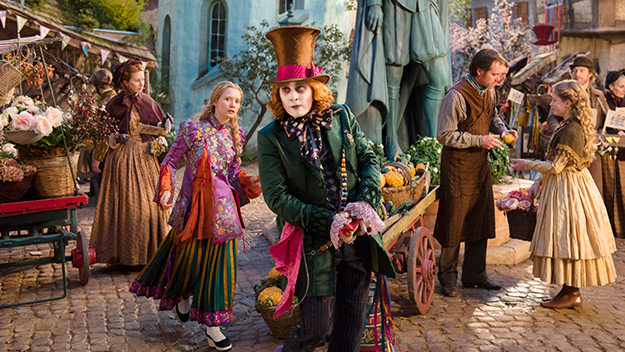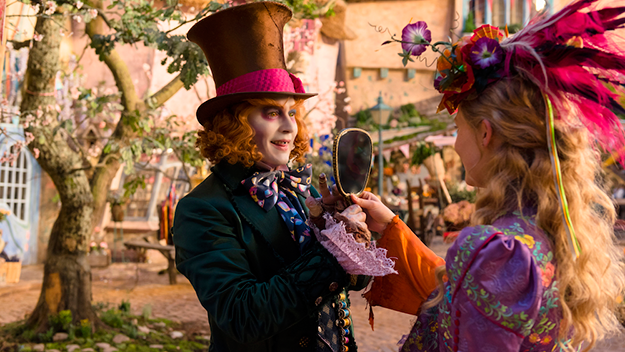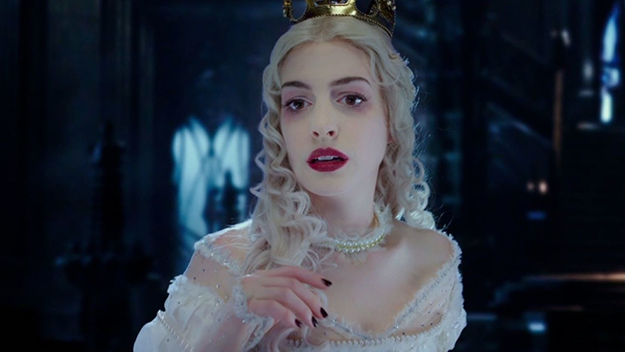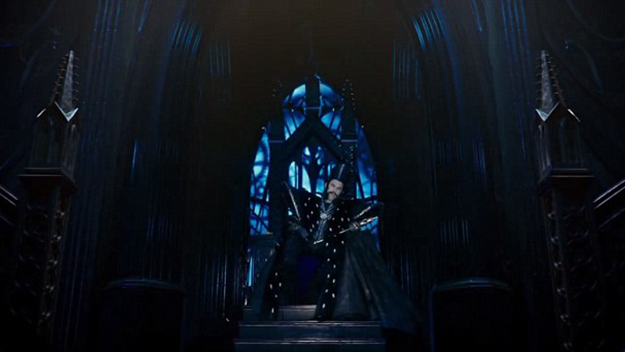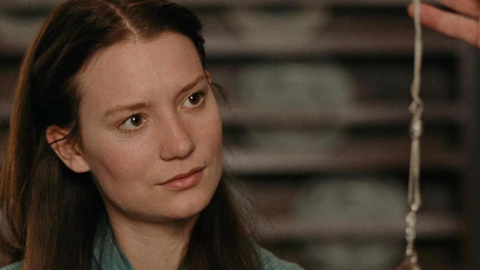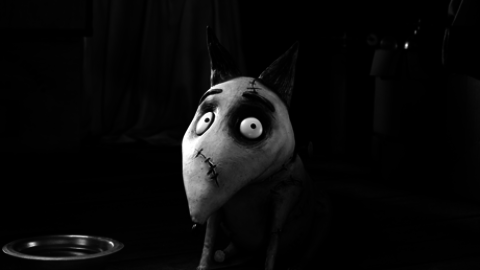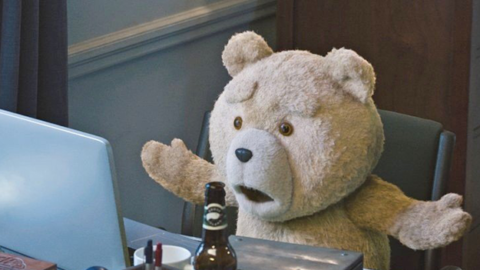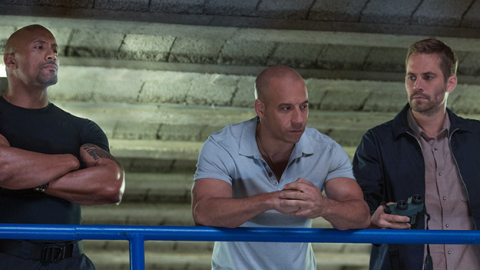Deep Focus: Alice Through the Looking Glass
Alice Through the Looking Glass is the misbegotten sequel to a blockbuster that became one of the most influential movies of the decade: Tim Burton’s Alice in Wonderland (10). Burton commercially rehabilitated a venerable title by glutting it with special effects, inserting a new story to add rooting interest and “heart,” and doing it in live action rather than animation. (Make that semi-live: there were a lot of semi-computerized bodies and faces.) The result was a travesty of Lewis Carroll—Burton said he’d never connected with the book—and an emotionally leaden super-production, but it also was a smash.
Since most people saw it as a flesh-and-blood iteration of an old-school Disney cartoon, Disney executives thought they’d found a potent new box-office formula: rejiggering cartoon features or analog Hollywood classics into CGI extravaganzas with star-laden casts and pasted-on subplots filled with “empowerment” and “redemption.” Burton’s Alice in Wonderland paved the way for (among others) Sam Raimi’s Oz the Great and Powerful and Robert Stromberg’s Maleficent. Now comes Alice Through the Looking Glass, produced by Burton, directed by James Bobin (the vaudevillian maestro of the last two Muppet movies, off his game), and once again written by Linda Woolverton, whose talents meshed better with the fairy-tale world of Charles Perrault in Beauty and the Beast a quarter-century ago than they do with Lewis Carroll’s genius silliness.
I’d missed Burton’s Alice movie, so when the lights went down for Bobin’s, and Mia Wasikowska’s Alice strutted on screen as the skipper of the Wonder, escaping a trio of Malayan pirate junks by steering her Tall Ship between shoals, I thought for sure it was a dream sequence. No such luck. These movies transform the heroine from a humorous, curious, changeable, often argumentative 7-year-old into a grownup action heroine. In the first film, she follows the White Rabbit down the hole after she spurns a marriage offer to an obnoxious young nobleman. In Burton’s “Underland” (the new name is a particularly lame twist), she proves her mettle and moral agency by beheading the fearsome Jabberwocky, thus saving the loony, lovable creatures of the ethereal White Queen (Anne Hathaway), including the Mad Hatter (Johnny Depp), from the clutches of the comically rapacious Red Queen (Helena Bonham Carter). Back aboveground, she declares that she wants a place in her late father’s trading company, not a stately mansion. But as Alice Through the Looking Glass continues, we learn that her dad’s business partner has died, too, and her spurned suitor (the partner’s son) has taken over the business. While Alice was on a lengthy voyage to open up new trade routes to China, he laid down an ultimatum to her debt-ridden mother (Lindsay Duncan): sign away either the Wonder or your house. When her mother naturally chooses the house, Alice tells her: “The last thing I want in life is to end up like you.” Then she follows a blue butterfly through a looking glass and into Underland once again.
The butterfly is the new incarnation of Absolem, the previous film’s blue caterpillar, voiced by the late Alan Rickman, and he has summoned her back to find out why the Hatter has stopped throwing mad tea parties and lost his joie de vivre. The Hatter has discovered evidence that his parents and siblings, thought to have perished when the Jabberwocky incinerated a fairground, are alive. After a tireless search, he has given up trying to find them. As Alice plays psychological detective, she uncovers primal scenes between the Hatter and his father and between the Red and White Queen when they were little sisters. Everyone, including Alice, learns the importance of love, forgiveness, and family.
As that bare-bone précis indicates, the problem with these Alice movies is not a lack of plot, but a surfeit of it. Alice Through the Looking Glass even contains a chronology-fracturing narrative in which she plays tag with the personification of Time (Sacha Baron Cohen). She uses a gyroscope-like device that stabilizes Time’s Great Clock—the Chronosphere—as a time machine. She attempts to prevent the catastrophe that both turns the Red Queen wicked and ultimately triggers the Hatter’s near terminal depression. Playing with Time teaches her yet another lesson: you can’t alter the past, but you can learn from it.
Such didacticism dampens Carroll’s imagination and puts a lid on Alice’s personality. She keeps learning therapeutic bromides and fighting a junior-feminist good fight. She rarely revels in the beauty and magic of sheer possibility, the one quality all readers can savor in Carroll’s nonsense epics, whether or not they understand the comic multitudes of allusions and puns. The scads of additional movie subplots deaden the Cheshire Cat, the Dormouse (or “Mallykum”), and the White Rabbit (or “McTwisp”). Beloved characters and a few stock “new” ones, like Bayard the Bloodhound, pop in and out, leaving scarcely a ripple or tickle in their wake. Woolverton’s writing makes too many of them seem similarly manic or peppy. She tries to insert as much of Carroll’s inspired gibberish as she can, and match it with her own, but her signature lines resemble comic-book deep thoughts.
In Carroll’s Alice in Wonderland, the author notes: “So many out-of-the-way things had happened lately, that Alice had begun to think that very few things indeed were really impossible.” In Carroll’s Alice Through the Looking-Glass, Alice declares, “One can’t believe impossible things,” and the White Queen answers, “I daresay you haven’t had much practice. When I was your age, I always did it for half-an-hour a day. Why sometimes I’ve believed as many as six impossible things before breakfast.” Woolverton makes the “six impossible things” sentence a program to be followed, not an offhand exclamation; Alice says it to herself before she defeats the Jabberwocky in the first film. The rest of this talk of the impossible becomes an anodyne lesson handed down by her father: “The only way to achieve the impossible is to believe it is possible.”
It’s tempting to blame the writer for something else as well: the too-cute meshing of three different household dramas (Alice’s, the Hatter’s, and the Queens’; you half expect the March Hare to explain that Mom always liked his two hundred brothers best). Burton was the one who took credit for ostensibly deepening Alice’s character in the previous movie. And his resume does contain equal amounts of quirk, melodrama, and bathos. Even his breakthrough Batman committed the error of having the Joker kill Bruce Wayne’s parents, shoving everything together in one neat little jack-in-the-box.
Bobin, who can do low-key, as in TV’s Flight of the Conchords, and keyed-up, as in Muppets Most Wanted, goes no-key in Alice Through the Looking Glass. He directs so anonymously, it’s as if he’s imitating Burton on a bad day. He packs the frame with visual filigree while pacing the film as a nonstop chase, so the outcome is numbing, not dazzling. He fails to allow spaces for wit and wonder. Wasikowska is surprisingly wan in both movies, and Depp’s concept of playing the Hatter like a human mood ring gives the audience nothing to focus on but his crazy hair and jeepers-creepers eyes. Bonham Carter is superbly brusque as the bulbous Red Queen, but her ruthless shtick wears thin, and she’s saddled with the sappiest of Woolverton’s inventions: yet another post-Wicked variation on a witch more bitched against than bitching. Bobin, who worked with Sacha Baron Cohen on Da Ali G Show, gets more value out of that daredevil comic actor: his all-suffering air and mental denseness are often very funny.
The one actor who almost always floats above the fray is Hathaway. When she plays a stylized role like Catwoman (in Nolan’s The Dark Knight Rises) or The White Queen, her delight in make-believe and her mastery of theatricality help her establish an otherworldly ambiance that’s exulting. Portraying the White Queen with an exaggerated airiness and an odd, dizzy detachment, she maps out her own zone of irony. She conveys the sense that this reputedly righteous monarch doesn’t really know what’s going on—or, perhaps, doesn’t believe in it—and her distance from the material ignites laughs and forges a bond with the audience.
It’s too bad that even she must learn that love means having to say you’re sorry. It’s Bobin and Woolverton who should apologize—to the cast, and to the audience.
Michael Sragow is a contributing editor to FILM COMMENT and writes its Deep Focus column. He is a member of the National Society of Film Critics and the Los Angeles Film Critics Association. He also curates “The Moviegoer” at the Library of America website.



